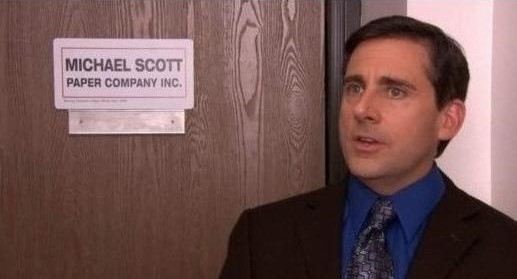As a proud Gen Xer, I cannot say that I watch anything on television that would be considered “new” or “current.” So when I had the flu recently, I turned to an old reliable and watched reruns of The Office (which, if you refuse to cut the cord, can be found at all times on at least one cable station). The episodes were from Season 5, when Michael, Pam, and Ryan quit Dunder Mifflin and opened up a competitor, the Michael Scott Paper Company. I loved how the creators included a new opening title sequence with the same catchy jingle but using scenes from the Michael Scott Paper Company.
Because most attorneys cannot divorce themselves from the profession, even when sick, I couldn’t help myself from ticking off all the potential safety hazards at the Michael Scott Paper Company. For those who didn’t watch or don’t remember the episode, the Michael Scott Paper Company was headquartered in a storage closet between Dunder Mifflin and Vance Refrigeration. There were no windows. Sewer pipes ran through the room, there was an exposed shower, and toilets could be heard flushing while our heroes tried to undercut Dunder Mifflin’s market share in selling paper to local businesses in Scranton. While an OSHA investigator wasn’t in the cards (how great would Nick Offerman as Ron Swanson been in that role), there wouldn’t have been an easier job for a government investigator hellbent on finding a safety violation at the Michael Scott Paper Company.
Finding safety violations took on a whole new meaning just last week when OSHA issued a final rule expanding the right of workers to choose a representative during a safety inspection. Characterized as the “walkaround rule,” employees now have the right to select virtually anyone to inspect the work site along with the OSHA inspector, employer property rights be damned. There was little guidance as to the expertise or competence required of this “wing man.” The rule only says that they should be people with “a variety of skills, knowledge, or experience that could aid” the inspection. Building inspectors, engineers, and instructors at occupational colleges would seem to fit the bill.
But the intent was to provide access to union business representatives and organizers, and they stand to gain the most from the new rule. While many union business representatives already are present during walk arounds at unionized facilities, under the new rule, an employee at a non-union company has the right to engage a union BA or organizer to enter the workplace (to which they otherwise would be trespassing), fashion an opinion on safety issues, and point out other perceived safety hazards. They also can, and likely will, seek potential unfair labor practices that could be critical to an already commenced or new organizing campaign. They likely will be able to talk with other employees and potentially review confidential documents to which they never would have been privy in the absence of this new rule. In a statement after publication of the new rule, a representative from the National Federation of Independent Business’ Small Business Legal Center stated, “This rule is not about worker safety…It is about facilitating the intimidation of small business owners by allowing unions to initiate and participate in inspections of workplaces they wish to infiltrate.”
The new rule is likely to be challenged in the courts and, should Congress and the Presidency change hands in November, you can bet that Republicans will view the need for union intervention differently. And while this will be the new world order for at least a few months, employers (especially non-union ones) should consider the following:
- Be vigilant about known safety hazards. When these are seen or reported, fix them immediately.
- Be proactive and seek out unreported safety hazards. Whether there is a dedicated employee for this or a team of employees, everyone should be seeking out and reporting conditions may be considered unsafe.
- Consider forming a safety committee composed of both management and employees to regularly meet to discuss safety issues in the workplace. Empowering employees in this regard may obviate the need to look outside.
- Learn, and where possible, challenge the credentials of the union representatives. If you run a health care facility, a union organizer from the Ironworkers may not have the “ skills, knowledge, or experience that could aid” the inspection.
We may never know whether Pam or Ryan would defy Michael and organize the Michael Scott Paper Company. But had this new rule been introduced fifteen years ago, Michael would have been forced to open his door to a new character that he would have found more detestable than Toby.
Rob Entin is partner at FordHarrison.


